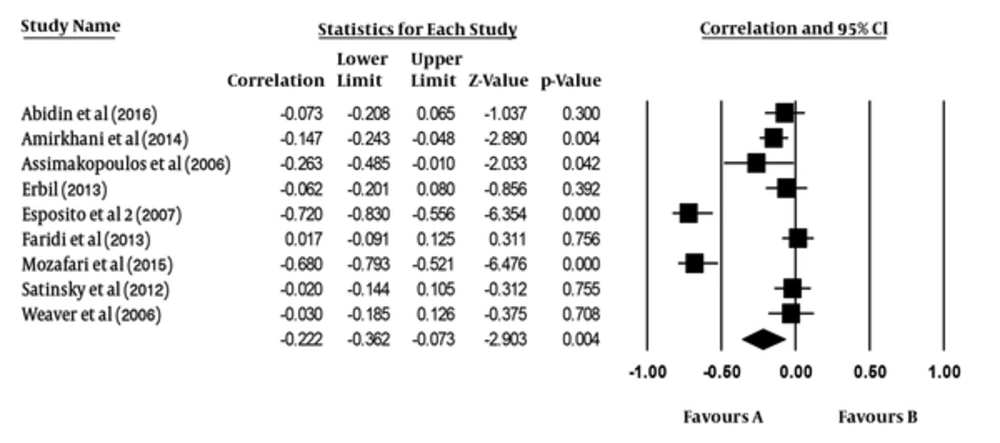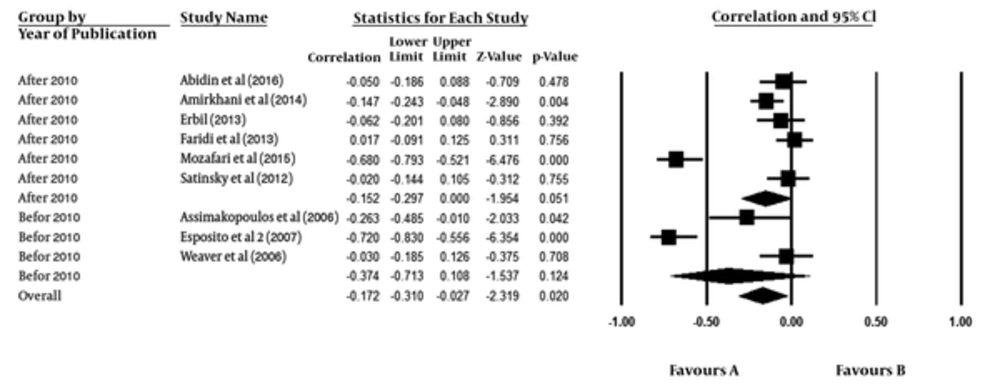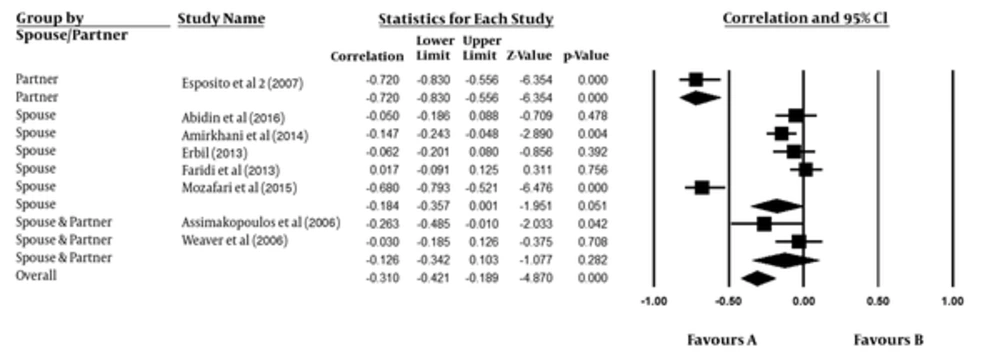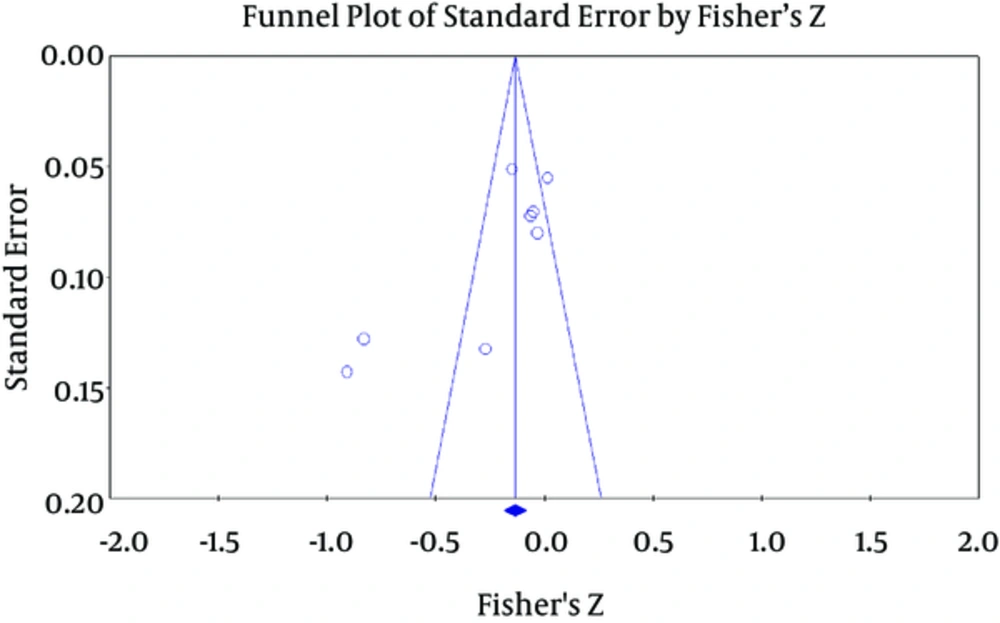1. Background
Sexual function is an important indicator of quality of life. Despite the fact that the sexual relationship is one of the essential human needs, impairment of sexual function occurs in some cases (1, 2). The World Health Organization considers sexual dysfunction as the inability of an individual to participate in sexual relationship, as he/she would wish (3, 4). Sexual dysfunction in women’s life appears as disorders of sexual desire, arousal, orgasm, and pain during intercourse (1). In fact, sexual dysfunction is influenced by a variety of biological and psychosocial disorders that occur in various stages of the sexual cycle, resulting in an inability to have intercourse or unpleasant feeling during intercourse (5).
There is evidence that the prevalence of sexual dysfunction varies in different countries and among men and women (6-11). This problem can lead to diminished self-esteem, feeling of guilt, sexual incompatibility with spouse, dissatisfaction in marital affairs, conflicts, and divorce as well as emotional distress (12). Thus, examining this disorder is a major research priority in the present century (8, 13). In this regard, many researchers have studied its connection with numerous emotional, psychological and social issues, especially physical factors like body mass index (1, 12-16).
Today, the trend of obesity among women throughout the world is associated with numerous negative effects on their quality of life (17) and it has the potential to promote sexual dysfunction in several ways (18). Many studies have been done around the world on the correlation between body mass index and sexual dysfunction although their results have been contradictory (14, 19-26). For example, a study by Esposito et al. (2007) indicated that BMI was strongly associated with female sexual dysfunction (26). On the contrary, this relationship was not significant in the Abidin (2016) and Erbil (2013) studies (19, 21). To have a full picture of the relationship between body mass index and sexual dysfunction in women, this meta-analysis was conducted to pool the results of the current observational studies.
2. Methods
2.1. Search Strategy
In order to find candidate studies, a comprehensive search was done in databases including PubMed/Medline, Science Direct, Scopus, Web of Knowledge, Springer, Google Scholar as well as Scientist information database and Magiran (Persian databases) without time and language restriction until October 30th 2016. The following search terms were used: “Body Mass Index” AND “sexual dysfunction” AND women. In addition, the reference list of the articles included in the meta-analysis and articles that have been cited were evaluated. Data extraction was performed independently by two authors.
2.2. Inclusion/Exclusion Criteria
Correlational studies were included if they assessed the relationship between BMI and sexual function in women, reported total score of sexual dysfunction, and presented the relevant 95% CI. On the other hand, review studies, systematic reviews, letters to the editor, case studies, studies on the relationship between body mass index scale and some subscales of sexual dysfunction scale, and studies with repeated publications were excluded from the present study.
2.3. Extracting Information
Two researchers independently extracted the following information: author’s first name, year of publication, study design, country of origin of the study population, sample size, mean age and age range of participants, status of sexual function (with and without sexual dysfunction), relationship status (having spouse, partner, or having both spouse and partner), fertility status, measuring tool of sexual dysfunction, quality assessment of papers, and the correlation coefficient among the main concepts in each study. Any disagreements were resolved by reaching a consensus among the members of the research team during the selection procedure.
2.4. Quality Evaluation
The quality of studies included in this meta-analysis was examined by the qualitative assessment tool of descriptive studies (27). For this purpose, the articles showing less than half of the criteria were excluded; those having 50 to 75% of the criteria were placed in Group B and those that gained more than 75% of relevant standards were placed in Group A.
2.5. Statistical Analysis
Because of the presence of heterogeneity across selected studies for meta-analysis, a statistical analysis was carried out using the random-effects model. Heterogeneity was investigated using Cochran’s Q statistic and quantified using I2 index. Additionally, subgroup analysis was conducted in order to determine the real heterogeneity in the studies and their possible association with the research covariates such as year of publication, sexual communication manner (spouse or partner), and fertility status of articles.
Funnel plots and Egger’s regression intercept were used to evaluate the presence of publication bias in the literature and its magnitude (28). Statistical analysis was performed with Comprehensive Meta-Analysis software (version 3).
3. Results
Figure 1 shows the flow diagram of selected studies in this meta-analysis. By performing a comprehensive search using the search strategies in the databases, 14,415 studies were retrieved. After excluding duplicates, 14,310 studies remained. Of these, 14,196 studies were excluded from the study in initial screening of titles and abstracts because of unrelated topic or lack of access to full-text of articles. The full text of remaining 114 articles was examined in detail, and 105 of these articles were excluded at this stage (studies with duplicated publication, review articles, letters to the editor, and case studies). At the end, 9 studies that had examined the correlation between body mass index and sexual dysfunction on 1,693 female participants were included in the meta-analysis (14, 19-22, 24-26, 29). Overall, the meta-analysis was conducted with 9 studies. The baseline characteristics of the selected studies are shown in Table 1.
| First author | Study Design | Year | Country | Sample Size | Mean Age | Age Range | Sexual Communication Manner | Fertility Status | FSFI |
|---|---|---|---|---|---|---|---|---|---|
| Abidin et al. | Cross-sectional | 2016 | Malaysia | 204 | 39 | NA | Spouse | Premenopausal | |
| Amirkhani et al. | Cross-sectional | 2014 | Iran | 384 | 28.6 | 15 - 45 | Spouse | Premenopausal | FSFI |
| Assimakupo- los et al. | Case control | 2006 | Greece | 60 | 35.7 | 18 - 56 | Spouse and partner | Premenopausal | FSFI |
| Erbil | Case control | 2013 | Turkey | 193 | 30.70 | 18 - 50 | Spouse | Premenopausal | FSFI |
| Esposito et al. 2 | Case control | 2007 | Italy | 52 | 42.3 | NA | Partner | Pre- or postmenopausal | FSFI |
| Faridi et al. | Cross-sectional | 2013 | Iran | 330 | 30.08 | 15 - 45 | Spouse | Premenopausal | FSFI |
| Mozafari et al. | Case control | 2015 | Iran | 64 | 32.8 | 18 - 50 | Spouse | Premenopausal | FSFI |
| Satinsky et al. | NA | 2012 | USA | 247 | 29.76 | 18 - 58 | NA | Premenopausal | FSFI |
| Weaver et al. | Case control | 2006 | Canada | 159 | 20.64 | NA | Spouse and partner | Premenopausal | SFQ |
Characteristics of Included Studies
Figure 2 shows Forest plot of body mass index and sexual dysfunction correlation in participants of the included studies. Of the 9 articles studied in the meta-analysis, a weak and inverse relationship was reported between body mass index and sexual dysfunction (14, 20) in two studies, and a strong relationship was found in two other studies (24, 26). However in five cases, no relationship was reported between these concepts (19, 21-23, 25). In general, the pooled results of this study showed a weak and inverse relationship (Pooled Correlation = -0.222; 95% CI -0.362 - 0.073) between body mass index and sexual dysfunction in women (Figure 2).
Cochran Q index also indicated the heterogeneity of 73.574 (P < 0.001) among the studies included into the meta-analysis. I2 index showed high real heterogeneity in these studies, as well (I2 = 89.12%).
In subgroup analysis by the year of articles published (when analysis was limited to two groups of studies after 2010 and studies before 2010), the pooled results were -0.152; 95% CI, -0.297 - 0.000 and -0.374; 95% CI -0.713 - 0.108, respectively (Figure 3).
The subgroup analysis by sexual communication manner (three different groups: partner, spouse, and spouse and sexual partner) showed that the pooled results were -0.720; 95% CI -0.830 - 0.556, -0.184; 95% CI -0.357 - 0.001 and -0.126; 95% CI -0.342 - 0.103, respectively (Figure 4).
Further, to assess publication bias, the Funnel plot and Egger’s regression intercept were used. Figure 5 shows Funnel plot of publication bias for correlation of body mass index with sexual dysfunction. Egger’s regression intercept was -6.736; 95% CI, -12.494 - 0.977 and Begg and Mazumdar rank correlation was -0.428 (0.137) indicating symmetrical funnel plot. Moreover, no evidence of publication bias (plot follows) was observed between BMI and sexual function.
Sensitivity analysis was performed and the results were not noticeably different from the pooled sensitivity of all eligible studies in this meta-analysis.
4. Discussion
To our knowledge, this is the first meta-analysis focusing on the evaluation of relationship between body mass index and sexual dysfunction in women. In general, the present meta-analysis indicated a weak and inverse correlation between body mass index and sexual dysfunction in women (Pooled Correlation = -0.222; 95% CI -0.362 - 0.073).
The factors such as endothelial disorder, dyslipidemia, changes in endocrine function, associated chronic diseases, obstructive sleep apnea, mental or social problems are the possible mediators of the relationship between obesity and sexual function. Medical treatment can also be considered as another possible risk factor for the effect of obesity on sexual function in women (18, 30, 31).
The results of this meta-analysis are consistent with a previous meta-analysis by Pontiroli et al. that also indicated a meaningful correlation between BMI and sexual function in diabetics (irrespective of the type of diabetes) (32). Moreover, Larsen (2005) in a review of cross-sectional and prospective studies found a correlation between obesity and erectile dysfunction in men (18). Consistent with these findings, most weight-loss interventions have been associated with improved sexual function in both men and women (33-35). The results of a review conducted by Kolotkin et al. also showed a higher incidence of sexual dysfunction in obese men and women compared to normal individuals. In addition, the results of this study suggest that combination of obesity with other simultaneous morbidity highly increases the risk of sexual dysfunction (15). Natarajan et al. (2009) reported that the incidence and severity of erectile dysfunction in men increase with obesity. According to this review study, sexual dysfunction in women, like in men, is associated with obesity although this association in women is still disputed (36).
The findings of the present study illustrate a high heterogeneity (I2 = 89.22%) in the studies included into the meta-analysis. A modest inverse association was also found between sexual dysfunction and body mass index in women with a partner in comparison with married women. No relevant evidence was obtained in reviewing literature. Furthermore, there was no heterogeneity among studies related to participants’ mean age, age range, and fertility status in the present meta-analysis. This heterogeneity may be associated with other variables such as length of marriage, parity, alcohol use, smoking, and mental disorders like depression.
In general, the findings of this study show a weak and inverse relationship between body mass index and women’s sexual function. Several limitations should be acknowledged. First, the explanation of the causality relationship between BMI and sexual function seems impossible according to cross-sectional studies. Longitudinal studies are more valuable in evaluating these causal relationships. Thus, in future studies, an investigation on the impact of obesity on female sexual function while controlling the factors known effective on sexual function is recommended.
Furthermore, despite that an extensive literature review was performed to identify studies, it is possible that some unpublished studies were missed.
4.1. Conclusion
In conclusion, the present meta-analysis provides further evidence in support of a weak and inverse relationship between BMI and female sexual function. The results of this meta-analysis provide new information for clinicians. Considering the increasing prevalence of obesity and its correlation with sexual function, evaluation of women at risk in clinical settings to identify individuals who would benefit from interventions is of great importance. Health workers should provide sexual counseling along with exercise and dietary intervention for individuals. In addition, it seems that the relationship of these variables is overshadowed by numerous other factors. Further research needs to be done in this area focusing on these factors.




